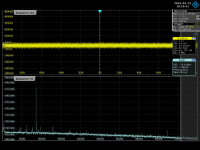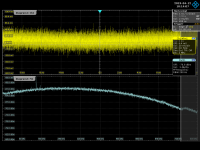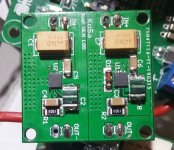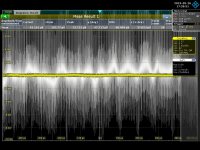LT3045 LT3094 Positive and Negative Low Noise Regulated Linear Power Supply New | eBay
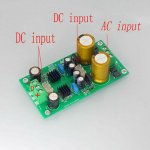
Any first hand experience or measurement with this PSU board? It uses the LT3045 and LT3094. If those were genuine IC, the noise performance should be very good. The small heatsink may need a 30-40mm cooling fan if more than 100 mA output is desired. The small board size is very attractive for low power, phono stage application.

Any first hand experience or measurement with this PSU board? It uses the LT3045 and LT3094. If those were genuine IC, the noise performance should be very good. The small heatsink may need a 30-40mm cooling fan if more than 100 mA output is desired. The small board size is very attractive for low power, phono stage application.
The layout around the regs does not follow the datasheet recommendations for low noise. Also using 0805 caps around the regs means they are 25VDC rated at best which if biased to near 20VDC will lose most of their capacity. The distance between the set resistor and the reg is enormous. The set pin seems also lack the guard ring so no way these regs will produce datasheet claimed low noise figure.
I am also wondering how did they manage to make it so cheap. I recently put together a BOM for a similar project and it came out around 30~40 euro. Assuming they save on the bulk order I still can't see where they make their money unless all parts are salvaged or coming from some other questionable source.
Regards,
Oleg
I am also wondering how did they manage to make it so cheap. I recently put together a BOM for a similar project and it came out around 30~40 euro. Assuming they save on the bulk order I still can't see where they make their money unless all parts are salvaged or coming from some other questionable source.
Regards,
Oleg
Buy it. It’s wonderful.
"Wonderful" or "too good to be true" do not really answer my question. Oleg's comment on the board layout is relevant, but how much it really degrades the noise performance? If the board uses genuine IC, it may have potential for good results, even if it is NOT optimized for the ultra low noise. I consider its price to be consistent with assembly using genuine parts, but there is not way to tell unless someone measures it.The layout around the regs does not follow the datasheet recommendations for low noise. Also using 0805 caps around the regs means they are 25VDC rated at best which if biased to near 20VDC will lose most of their capacity. The distance between the set resistor and the reg is enormous. The set pin seems also lack the guard ring so no way these regs will produce datasheet claimed low noise figure.
I am also wondering how did they manage to make it so cheap. I recently put together a BOM for a similar project and it came out around 30~40 euro. Assuming they save on the bulk order I still can't see where they make their money unless all parts are salvaged or coming from some other questionable source.
Regards,
Oleg
The LT3045 and LT3094 are less than $4.00 each in bulk (>250 order) in retail in the US. (Mouser or DigiKey) It may be cheaper in China. The $20 price for a dual rail PSU is not unreasonably cheap. Otherwise, I would not have started this thread.I put the single rail bom at under $10 for 1000
The layout around the regs does not follow the datasheet recommendations for low noise. g
Wow, no kidding, huge missed opportunity there.
The LT3045 and LT3094 are less than $4.00 each in bulk (>250 order) in retail in the US. (Mouser or DigiKey) It may be cheaper in China. The $20 price for a dual rail PSU is not unreasonably cheap. Otherwise, I would not have started this thread.
It is only 20$ and shipping is free. May be you can get one and check it out first hand!😀😀
Regards,
Interesting unit, wonder how it would stack up against the Chinese Clone Studer900, which are a little pricier but Very,very quiet.
Cheers
If you are referring to a clone of Studer 900 console PS, they are very noisy
in comparison to LT3045. Probably > 20 x the noise.
TCD
Would you have any measured data to share with us?
The 0.8uV noise mentioned by everyone is from the data sheet of LT3045 (I presume that's what you are referring to). It will be more informative to see what the noise level would be in a "complete" regulation implementation. I have not seen any yet. I will be grateful if you have some info to share.
Regards,
The 0.8uV noise mentioned by everyone is from the data sheet of LT3045 (I presume that's what you are referring to). It will be more informative to see what the noise level would be in a "complete" regulation implementation. I have not seen any yet. I will be grateful if you have some info to share.
Regards,
I already have a Chinese Clone Studer900 kit to be assembled and the LT3045/LT3094 PSU is on the way. I will find out how good or bad they are and report back here in a few week/month.It is only 20$ and shipping is free. May be you can get one and check it out first hand!😀😀
Regards,
I do not have a spectrum analyzer or low noise broadband amplifier to do quantitative noise measurement. I have an Owon 50MHz oscilloscope and a Fluke 45 bench multimeter which, hopefully, would allow me to do a rudimentary comparison. And also for comparison to LT1083CP based PSU that I have been using for DAC, lineamp and headlamp. Any suggestion on how to do the comparison or make better PSU noise measurement is greatly appreciated.
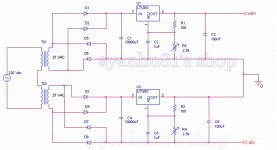
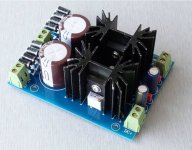
I am building a MC phono stage designed by Wyn Palmer. The PSU is in a separate box.
Last edited:
It's not the Chinese unit, but made by us: a dual pos/negative LDO based on the LT3045/ LT3094.
The cost of making it in a small series had been definitely more than 20$
Here it is a short approximate test about the noise of the modul (LT3045 at 4,3V output).
First graph is the baseline of the preamp with 80dB gain (input shorted) (Amp is IP of Gerhard Hoffman).
Second shot is a 60ohm resistor for reference. (1nV/sqrtHz)
Third is the LT3045 module's output
The cost of making it in a small series had been definitely more than 20$
Here it is a short approximate test about the noise of the modul (LT3045 at 4,3V output).
First graph is the baseline of the preamp with 80dB gain (input shorted) (Amp is IP of Gerhard Hoffman).
Second shot is a 60ohm resistor for reference. (1nV/sqrtHz)
Third is the LT3045 module's output
Attachments
As can be seen, the noise with regulator is ~2 times, 6dB higher than with the 60ohm reference (1nV) - so it is close to 2nV.
Also, with 100kHz bandlimit I have measured 1.1uV total noise (RMS)
Also, with 100kHz bandlimit I have measured 1.1uV total noise (RMS)
Interesting unit, wonder how it would stack up against the Chinese Clone Studer900, which are a little pricier but Very,very quiet.
You two are stating the extreme opposite. It is possible because you may measure different unit from different seller on e-bay.If you are referring to a clone of Studer 900 console PS, they are very noisy
in comparison to LT3045. Probably > 20 x the noise.
Can you share the name of your vendor and also your noise measurement setup and results? Thank you to both of you in advance.
Here is another shot, when we used it as a linear regulator stage on the output of a switching PS. This is a very un-scientific demonstration clearly only for being impressive.. (gray trace is without the LDO, directly the switcher's output. Yellow trace is with LDO inserted)
But it shows the high frequency noise suppressing capabilities (also from the noise spectra it could be seen, note the scale of the graph - 800kHz)
But it shows the high frequency noise suppressing capabilities (also from the noise spectra it could be seen, note the scale of the graph - 800kHz)
Attachments
Last edited:
You two are stating the extreme opposite. It is possible because you may measure different unit from different seller on e-bay.
Can you share the name of your vendor and also your noise measurement setup and results? Thank you to both of you in advance.
I was referring to 900 console power supply.
Ref to schematic of '900 -24V rail. As far as I can see this would be a lot noisier
than an LT3045 based Reg. Obviously for it's intended purpose, it does the job,
has much more OP current, also has by the look of it, 'crow bar' over voltage
protection which many Pro Console supplies had.
But I wouldn't clone it for ULN applications.
TCD
Attachments
It's not the Chinese unit, but made by us: a dual pos/negative LDO based on the LT3045/ LT3094.
The cost of making it in a small series had been definitely more than 20$
Here it is a short approximate test about the noise of the modul (LT3045 at 4,3V output).
First graph is the baseline of the preamp with 80dB gain (input shorted) (Amp is IP of Gerhard Hoffman).
Second shot is a 60ohm resistor for reference. (1nV/sqrtHz)
Third is the LT3045 module's output
Looks nice.
The only thing I noticed with another suppliers LT3045 based reg
is that it had some very LF noise. I tracked it down to the MLCC bypass on
'Set' pin. You could also tap the board with your finger and see the
piezoelectric effect of MLCC as LF noise.
I think something else there would be better. It's a tough choice because film
caps are much larger in the uF's that 'set' wants to see.
TCD
Looks nice.
The only thing I noticed with another suppliers LT3045 based reg
is that it had some very LF noise. I tracked it down to the MLCC bypass on
'Set' pin. You could also tap the board with your finger and see the
piezoelectric effect of MLCC as LF noise.
I think something else there would be better. It's a tough choice because film
caps are much larger in the uF's that 'set' wants to see.
TCD
You can try an acrylic capacitor perhaps, like the Rubycon PMLCAP series. Still larger than I would like, but getting usable. I would probably still use an X7R in a larger package from a good manufacturer.
Actually, I am pretty sure it is an acrylic capacitor in the picture that Joseph posted.
Last edited:
LT3045 LT3094 Positive and Negative Low Noise Regulated Linear Power Supply New | eBay
View attachment 806732
Any first hand experience or measurement with this PSU board? It uses the LT3045 and LT3094. If those were genuine IC, the noise performance should be very good. The small heatsink may need a 30-40mm cooling fan if more than 100 mA output is desired. The small board size is very attractive for low power, phono stage application.
Looking at the image it simply inputs power 😀
The funny thing is that the heat is transferred on the underside of the LT3045 as it specifically requires a thermal area on the PCB under the chip. So cooling on top ok, but the real heat needs cooling through the PCB.. Other designs have far larger heatsinks. One way to reduce the heat is to have the input as close as needed (inc any drop off) to the required output.
Also you can have up to 3 LT3045s in parallel as part of the LT reference design.
You can try an acrylic capacitor perhaps, like the Rubycon PMLCAP series. Still larger than I would like, but getting usable. I would probably still use an X7R in a larger package from a good manufacturer.
Actually, I am pretty sure it is an acrylic capacitor in the picture that Joseph posted.
That appears to be on the OP Chris.
Yes had considered PML cap. They are getting expensive for something like
4.7uF.
WRT X7R, are you saying that larger sizes are less prone to piezo effect?
TCD
- Home
- Amplifiers
- Power Supplies
- Ultra low noise PSU on e-bay
